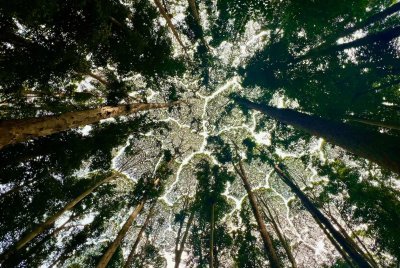Frederik Dawson 3.5
Forest Research Institute Malaysia
Forest Research Institute Malaysia (Inscribed)

Tucked quietly on the northern fringe of bustling Kuala Lumpur lies the Forest Research Institute Malaysia (FRIM), an ecological treasure that remains surprisingly unknown to many, even among locals. Despite being just a short drive from the city center, FRIM is often overlooked in favor of other well-known attractions. Yet it offers something far more meaningful: a rare, immersive glimpse into Malaysia’s forest conservation efforts and the quiet beauty of tropical reforestation. FRIM features two main attractions, the public Skywalk and the restricted Forest Walk on the Keruing Trail. While the Skywalk provides sweeping views above the canopy, the Forest Walk offers a more intimate, ground-level experience of the forest’s biodiversity and scientific significance. I opted for the Forest Walk, and it turned out to be the highlight of my visit though getting there took some effort. Booking the Forest Walk requires advance planning. The process is somewhat bureaucratic: you must email the FRIM office, await a reply, and then manually transfer the 150 MYR guide fee to a designated government bank account. There’s no online portal or instant booking system, which may feel outdated, especially for foreign visitors. However, once confirmed, the experience more than justifies the hassle.
Our guide was outstanding, informative, passionate, and deeply connected to the forest. What sets FRIM apart is that it’s not just a recreational park or nature spot. And importantly, FRIM is not a botanical garden. Unlike botanical gardens, which often cultivate plants in manicured, landscaped settings for display and educational purposes, FRIM is a living forest laboratory, where trees are grown in natural conditions, tracked over time, and studied for their ecological responses. Every tree has a purpose beyond aesthetics, each one is part of a long-term research project, contributing valuable data to understand tropical reforestation, forest management, and climate adaptation. Among the many unforgettable sights was the phenomenon of crown shyness, where the tops of tall trees grow apart, forming striking, mosaic-like gaps in the canopy. Our guide explained several theories behind it, from pest avoidance to light optimization, and it symbolized the quiet intelligence and cooperation in nature.
Due to the scientific importance of the site, FRIM does not allow unguided visits. This policy became strict after a difficult period during the COVID-19 pandemic, when public access was granted without supervision. Many locals, unaware of FRIM’s purpose, treated it like a regular community forest, picking herbs, digging up seedlings, and damaging research plots. As a result, FRIM lost a significant number of young trees and valuable data, some of which had taken years to collect. It was a sobering lesson in the importance of public awareness and protection. The forest is also physically vulnerable. To preserve the ecosystem, FRIM limits the number of visitors. Heavy foot traffic can lead to soil compaction and erosion, especially on slopes, which directly affects tree health and long-term forest structure. These concerns are even more urgent given that FRIM is under consideration to become a UNESCO World Heritage Site. While such recognition would bring global attention, it could also result in a sharp increase in tourist numbers, potentially threatening the very forest it aims to celebrate. To address this, FRIM has proposed building wooden boardwalks to protect the soil. While this would help reduce environmental impact and improve accessibility, there’s concern that it could also diminish the natural, immersive feeling of walking directly through the forest, one of FRIM’s most powerful experiences.
What makes FRIM’s transformation even more extraordinary is its origin story. It’s almost unbelievable that this dense forest was once an abandoned tin mining site, a barren, treeless landscape with poor, degraded soil. The area was considered ecologically dead, with little hope for natural recovery. Through decades of planning, planting, and scientific experimentation, FRIM turned what was once wasteland into a thriving forest, rich in biodiversity and ecological value. It stands today not just as a green space, but as proof that with commitment and science, even the most damaged land can be brought back to life. In conclusion, FRIM is a hidden gem that deserves far more recognition, but not at the cost of its ecological integrity. Though the booking process is a bit inconvenient, and access is limited, these measures exist to protect something rare and irreplaceable. FRIM is more than a forest, it is a living testament to Malaysia’s scientific dedication, conservation leadership, and the incredible possibility of ecological recovery, something that is worth being a World Heritage Site.
Comments
No comments yet.
